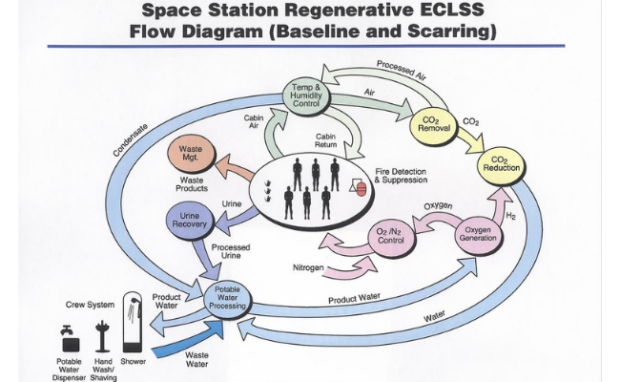NASA achieves water recovery feat in outer space
The National Aeronautics and Space Administration found a way to turn 98% of astronaut urine and sweat into safe drinking water. That was NASA’s goal when it created the Environmental Control and Life Support System and tested it on the International Space Station. As a result, astronauts can stay longer in outer space.
NASA continues to breach the boundaries of space exploration, so it needs better ways to sustain astronauts. The ECLSS allows these brave men and women to have more reclaimable water during missions. Perhaps this technology may help supply water to those who need it on Earth.
This article will discuss NASA’s breakthrough water purification technology. You will see how it works and how it significantly benefits astronauts. Later, I will explain how space technologies eventually become products we use daily.
How does NASA’s water recovery system work?

Photo Credit: nasa.gov
Most folks view astronauts as people floating inside a space vehicle or bouncing around on the Moon. Yet, we often forget the challenges astronauts face among the stars.
One of their biggest problems is having enough water during missions. Resupplying astronauts circling the Earth’s orbit is difficult and expensive, and sending water further could be next to impossible.
In response, NASA has been creating life support systems that recycle waste into useful materials. Its latest invention is the Environmental Control and Life Support System, and here’s how it works:
- The ECLSS Water Recovery System collects wastewater and sends it to the Water Processor Assembly (WPA).
- Then, the WPA produces potable water.
- Another specialized component uses advanced dehumidifiers to capture crew sweat and breath moisture. Meanwhile, the Urine Processor
- Assembly (UPA) takes water from urine using vacuum distillation.
- Afterward, the Brine Processor Assembly extracts more water from UPA urine brine.
NASA says the BPA was the key to achieving the system’s 98% water recovery goal. Christopher Brown, one of the people managing the Johnson Space Center’s life support system, lauded this breakthrough.
“This is a very important step forward in the evolution of life support systems. Let’s say you collect 100 pounds of water at the station. You lose two pounds of that, and the other 98% just keeps going around and around. Keeping that running is a pretty awesome achievement.”
Jill Williamson, ECLSS water subsystems manager, explains the system’s significance. “Before the BPA, our total water recovery was between 93% and 94% overall.”
“We have now demonstrated that we can reach a total water recovery of 98%, thanks to the brine processor. The less water and oxygen we have to ship up, the more science can be added to the launch vehicle.”
Could this NASA technology be useful on Earth?
@NASA now has the ability to recycle 98% of the water collected from the US segment on @Space_Station, meeting the threshold necessary for water recovery on long-duration space exploration missions. pic.twitter.com/3TSJblIpqo
— NASA ScienceCasts (@NASAScienceCast) June 20, 2023
NASA’s new water purification system may be useful when spending long periods in extreme conditions. Let’s take the OceanGate submarine that recently imploded.
According to HowStuffWorks, most underwater vessels distill seawater into drinking water. Perhaps the Titan could have used that or the ECLSS to sustain its crew.
Using NASA technology on Earth may seem far-fetched. Contrary to popular belief, several daily household items started from this space organization.
You may also like: How To Share Your Wi-Fi Password
Applying the ECLSS to our lives could be possible. Maybe it could improve how we supply potable water to our communities. I listed a few items from NASA to prove my point:
- The Kennedy Space Center says the humble smartphone camera started as NASA’s CMOS active pixel sensor. It enabled astronauts to take clearer photographs of outer space. Nowadays, it lets you capture the perfect selfie!
- In the 1980s, NASA’s Ames Research Center needed to improve astronaut helmets. They must filter UV rays, enhance visibility, and resist scratches. It succeeded and applied that technology in consumer sunglasses, welder masks, and goggles.
- You can thank NASA for your cordless vacuum. The space organization partnered with Black & Decker to create battery-powered tools for Moon exploration. Nowadays, we use that wireless tech for numerous household products, specifically vacuum cleaners.
- In the 90s, NASA’s Jet Propulsion System needed to correct errors in its global receiver network. Consequently, it created the Global Positioning System (GPS), which enables location services for smartphone apps.
- Did you know NASA invented the first AI personal trainer? The LifeBEAM headphones had a voice assistant named Vi. It alerted pilots if they were about to blackout to g-forces while flying. Nowadays, your fitness watches and apps use that technology to track your fitness goals.
Conclusion
NASA created a revolutionary water recovery system for astronauts. It will allow these people to use resources more efficiently and sustain longer missions.
As a result, they may embark on further expeditions. For example, the space organization recently started training researchers for Mars exploration.
Soon, these brave men and women would probably use the ECLSS as they journey to become the first people on the red planet. Meanwhile, check out more digital trends at Inquirer Tech.